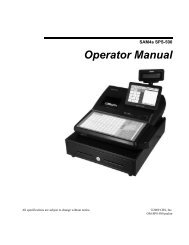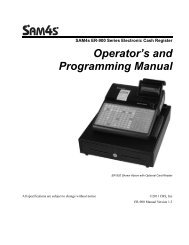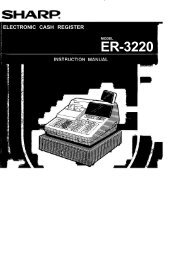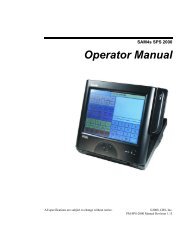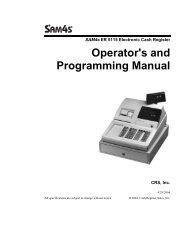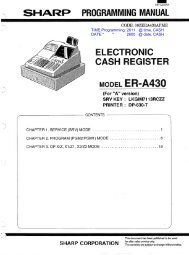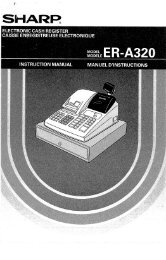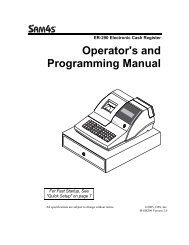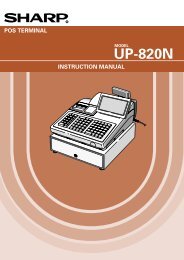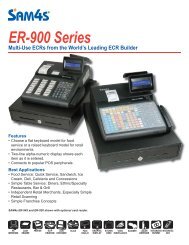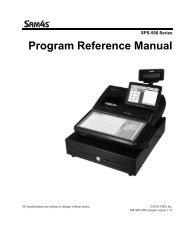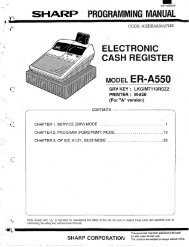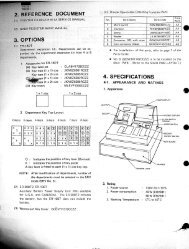ER-A520/ER-A530 INSTRUCTION MANUAL
ER-A520/ER-A530 INSTRUCTION MANUAL
ER-A520/ER-A530 INSTRUCTION MANUAL
You also want an ePaper? Increase the reach of your titles
YUMPU automatically turns print PDFs into web optimized ePapers that Google loves.
Procedure<br />
One- or two-*digit<br />
number<br />
Rate<br />
*2<br />
† @ @<br />
@<br />
M<br />
T<br />
max. three<br />
digits<br />
@<br />
max. six digits<br />
(0.0001 - 99.9999%)<br />
To delete a tax table, use the following sequence:<br />
One- or two-*digit<br />
number<br />
Rate<br />
*2<br />
@<br />
max. six digits<br />
(0.0001 - 99.9999%)<br />
max. four<br />
digits<br />
Q Minimum breakpoint<br />
@<br />
@ Ç<br />
max. five digits<br />
max. five<br />
digits<br />
Repeat until the MAX point is entered.<br />
† @<br />
M<br />
@ t<br />
max. four<br />
digits<br />
*1 First figure: The first figure to be entered depends upon whether the difference between a minimum<br />
breakpoint to be entered and the preceding minimum breakpoint is not less than $1.00 or<br />
more than 99¢. When the difference is not less than $1.00, enter “1,” and when it is not more<br />
than 99¢, enter “0” or nothing.<br />
Second figure: The second figure depends upon whether your tax table is to be programmed as tax table 1,<br />
2, 3 or 4. When your tax table is to be programmed as tax table 1, enter “1”; when it is to be<br />
programmed as tax table 2, enter “2”; when it is to be programmed as tax table 3, enter “3”;<br />
and when it is to be programmed as tax table 4, enter “4”.<br />
*2 If the rate is fractional (e.g. 4-3/8%), then the fractional portion (3/8) would be converted to its decimal<br />
equivalent (i.e. .375) and the resulting rate of 4.375 would be entered. Note that the nominal rate (R) is<br />
generally indicated on the tax table.<br />
Note<br />
If you make an incorrect entry before entering the M in programming a tax table, cancel it with the<br />
c key; and if you make an error after entering the M, cancel it with the ı key. Then program<br />
again from the beginning correctly.<br />
• Limitations to the entry of minimum breakpoints<br />
Your register can support a tax table consisting of no more than 72 breakpoints. (The number of breakpoints is<br />
36 maximum when the breakpoint difference is $1.00 or more.) If the number of breakpoints exceeds the<br />
register’s table capacity, then the manual entry approach should be used.<br />
Example<br />
Programming the sample tax table shown on the previous page as tax table 1<br />
Tax rate →<br />
M →<br />
T →<br />
Q →<br />
The first<br />
cyclic<br />
portion<br />
M1<br />
(MAX point)→<br />
Key operation<br />
Print<br />
†<br />
1 @<br />
6 @<br />
100 @<br />
1 @<br />
11 @<br />
23 @<br />
39 @<br />
57 @<br />
73 @<br />
89 @<br />
111 @<br />
a<br />
94<br />
Note<br />
You do not need to enter the trailing zeros of the tax rate (after the decimal point) but you do need<br />
to enter the decimal point for fractions.



